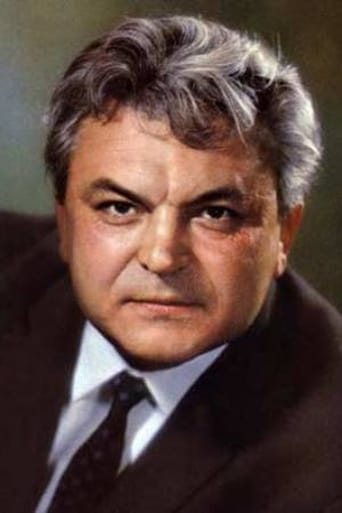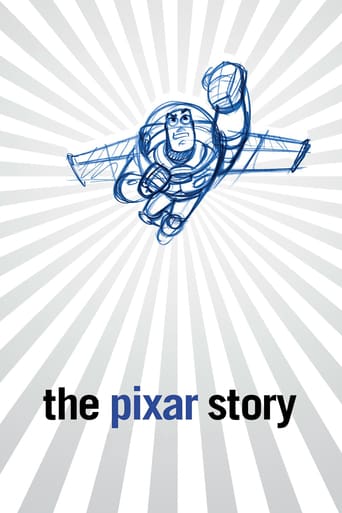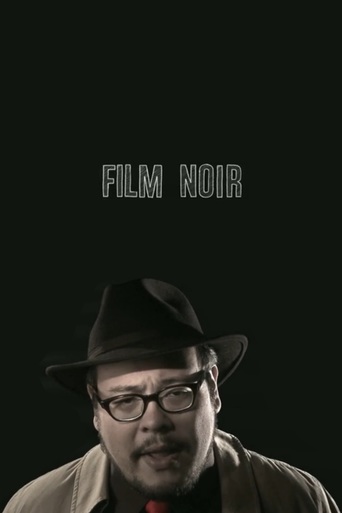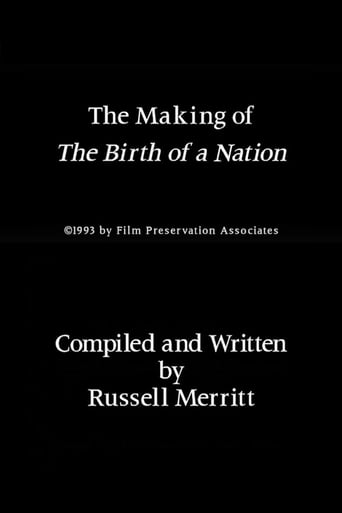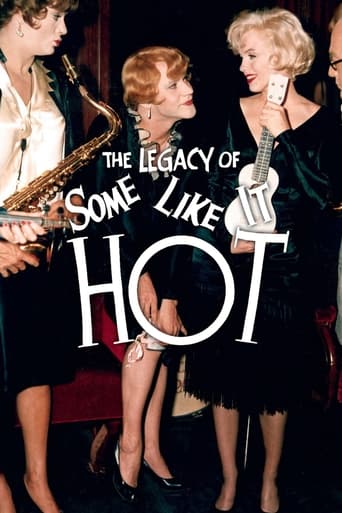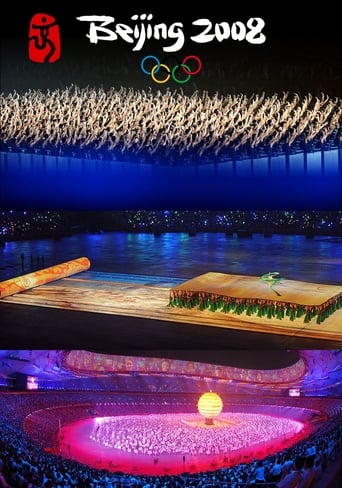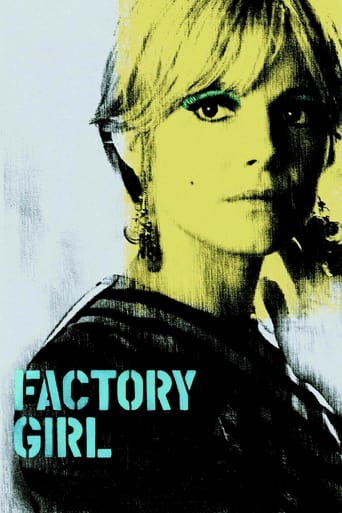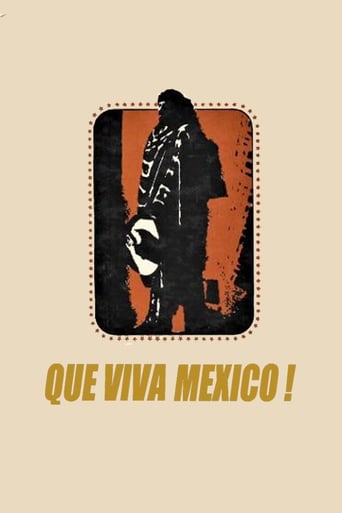

Que Viva Mexico! (1979)
Eisenstein shows us Mexico in this movie, its history and its culture. He believes, that Mexico can become a modern state.
Watch Trailer
Cast


Similar titles
Reviews
Slow pace in the most part of the movie.
Powerful
Overrated
It is an exhilarating, distressing, funny and profound film, with one of the more memorable film scores in years,
Viva La Riza! The movie portrays Mexican culture in a great way. It show the history of Mexico from pre-Conquest civilization to the Mexican revolutions of the early 20th century. Despite that, the movie is still a flawed masterpiece from Russian avant-garde director Sergei Eisenstein. The production for the film was beset by difficulties that Sergei couldn't stop. First off, shooting for the film was delay, by the Mexican government, due to the fact, that Sergei Eisenstein's films are known for their political subversion. Fearing that, Eisenstein would spark, yet another national revolt, toward communism. The Mexican government would only allow the Soviet filmmakers entry into their country, if they agree to their condition about how the film was going to be portray. In their agreement, the film was not to show or imply anything that could be construed as insulting to or critical of post-Revolution Mexico. This condition meant, that Sergei's original intended to document the mythic struggle of a Mexican people in a perpetual state of unrest, would not happen. If Sergei didn't comply with the agreement, the filmed material would be subject to censorship and taken by the Mexican government. In the end, the movie was never molded into the film that he has intended. Maybe it's a good thing, because Communist Propaganda driven movie, would be a harder film to watch. Another problem that Sergei face, during production was the lack of money, funding the trip. Most of the film's American financiers back off when the filming for the film went a little over budget during shooting. Things got worse for Sergei, when lead financier, Upton Sinclair stop funding the film, due to their disagreement on how the film was going to be shot. Upton Sinclair wanted an artistic travelogue; while Eisenstein wanted a multi-part film, almost like an anthology with each part focused on a different subculture of the Mexican peoples. The movie was supposed to be divide into six parts: Prologue, Sandunga, Conquest, Fiesta, Magey, Soldadera and Epilogue. The film as a whole, would have parts, base on some primal element (stone, water, iron, fire, air), and have a overlooking story of romantic as the movie moves from themes of life and death, culminating in the mockery of death. The soundtrack in each case would feature a different Mexican folk song. Sadly, the movie didn't go that way. After various projects proposed by Charles Chaplin and Paramount Pictures fell through. The studio released him from his contract, leaving the production with little to no budget. It didn't help that his own country, the Soviet Union was turning their back, from him, due to Eisenstein's foray onto the western culture. They saw it, as an act of betrayal. When Eisenstein try to defect to the United States, by entering American border, during production. They decline him, when they found out, that his re-entry visa had expired. With no studio to edit his film, he was forced to return to the Soviet Union, after production, but due to his vision of communism. It brought him into conflict with officials in the ruling regime of Joseph Stalin until Eisenstein's death in 1948. Due to these reasons, the film was shelf for years. In 1979, the Soviet Union government retrieved the fragments of the film, and forced assistant director, Grigori Aleksandrov to edit this movie, based on the notes and storyboard of Eisenstein. The film was divided in three parts. The first one introduction gives a historical panel of Mexico and the Mexican people. This part, was well-shot and felt like a documentary. This part in the film was very much influenced by the works of with Frida Kahlo and Diego Rivera as it moves as if the frames were frescoes. The second part doesn't feel like a documentary at all. The second part had a fiction story about a bride kidnap by a powerful farmer on her wedding day, and her fiancé, his brother and two friends trying to rescue her. It was a bit odd to watch. This part is example of avant-garde aesthetics, an exercise in form rather than documentary realism; but indirectly, recreate the Mexican culture atmosphere. Unfortunately, the conclusion of the story was never finish, as Eisenstein had no more money to film, the rest. The last part, called Epilog, tells the celebration of Day of the Dead AKA dia de finados, with the population wearing masks of skull and celebrating death. This part of the film was supposed to be the incarnation of Surrealism, but somehow the message was lost in this version of the film. Overall: It kinda hurts, that the movie was release, a little late. In many ways, the movie looks and feels somewhat dated. While, the film still displays all of Eisenstein's revolutionary techniques. It looks pretty cheap, looking. It didn't do a good job, proving his narrative style nor does it show Mexican in a realistic light. It look good, but just think, if the film didn't have all those roadblocks. It could have been great. In the end, this awe-inspiring film stands as a testament to what might have been.
If you know about Sergei Eisenstein's "Que Viva Mexico! - Da zdravstvuyet Meksika!", you probably know that Eisenstein ran out of money and left the movie incomplete, so collaborator Grigoriy Aleksandrov organized the footage as close to how Eisenstein envisioned it. I personally thought that it was a fascinating movie, but one of many films where they throw so much at you that it's really hard to digest.Knowing that Eisenstein met with the execs at Paramount Pictures but didn't see eye to eye with them, I get the feeling that he may have made this movie in part to indict US involvement in Latin America. As we Americans were supposed to view our southern neighbor as the land of sombreros and senoritas, he wanted to show that there was a more serious-intellectual side, and of course the indigenous aspect.In my opinion, the combination of the Day of the Dead sequence and the rebellion at the end really constitute the movie's strength, sort of like the rebellion in "Battleship Potemkin". Much of the rest of the film consists of very exaggerated facial expressions (the Russians love those, don't they?). But either way, I still recommend the movie as an important installation in cinematic history, exactly the sort of thing to show in film classes. If anything surprised me, it was that they were allowed to show nudity; I always sort of assume that no major movie in any country was allowed to back then (but don't get me wrong: some of those women were really hot!).
I have to start out by saying that i do not give this movie such a high rating based on Eisenstein's vision of the Mexican culture, but more on his amazing ability to manipulate time and space to create a new meaning. He is able to make us believe we are watching a documentary on Mexico when all along we are watching a movie about continuous progress through revolutions (Eisenstein communist vision). He starts his movie with a vision of proclaiming time in the episode Sandunga. Then in the next episode Fiesta he shows us the conquest of Cortes in the 16th century. Next its Maguey which is the dictator of Porfirio Diaz. The following episode is Soldadera (which is when Eisenstein ran out of budget) which is his representation of the 1910-1920 Mexican revolution. Finally, in the prologue he shows us a free Mexico. (He even slips a little of his ideology by representing the capitalists as the "doomed class".)This movie could easily be watched without even noticing this, but i think everyone should try to watch this and keeping in mind Eisenstein bolshevik background. He came to Mexico being financed by a communist writer, and was received by 3 communists mural painters...there was no way this could not be a typical communist, propaganda movie. At some times he represents wrongly Mexicans, but i truly believe its to achieve his main goal, that maybe he even did it on purpose in order to really show an evolution through time...To wrap it up; this movie, and this producer have an enormous and interesting past thats worth looking into to.
Film buffs know the history of this lost all too well- Eisenstein came to Hollywood to work for Paramount, Paramount and Sergei never really saw eye to eye. Before giving up on making an American Production, Upton Sinclair invited Eisenstein to make a feature film about Mexico. Eisenstein shot miles of footage, and the money and interest from backers ran out. Eisenstein was forced to return to his native Russia without his Mexican footage. The footage was cut together by others at about this time to make THUNDER OVER MEXICO, and they did not follow Eisenstein's editing notes (They simply made an edit every four seconds. Watch the film and count, you'll see what I mean...) This version, completed by his associates 30 years after his 1948 death comes close to Eisenstein's intent, but without Eisensetin at the editing board, something is missing. This resulting video is entralling. His incredible shot compositions (which influence me to no end as a film-maker) are all there. There's one scene, which involves a shoot-out reminds us what a John Wayne western directed by Eisenstein would of lookied like.


